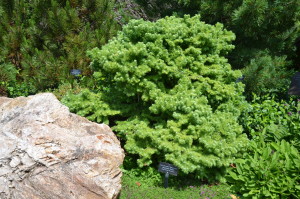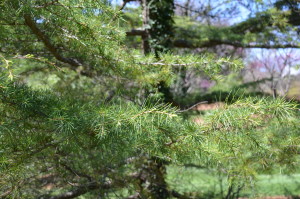Larches (Larix spp.) are majestic deciduous conifers in their northern ranges of their habitat (USDA hardiness zone 4 to 7). However, trees do not prosper in hot and humid summers south of USDA Zone 7.
One of the best is Japanese larch (Larix kaempferi), but unfortunately, it is not commonly planted in U.S. landscapes. The tree averages 50-60 feet in height and 25-35 feet in width. Old specimen trees that are 70-90 feet tall are not difficult to find in botanical gardens in zones 5 and 6.
The tree grows rapidly with an open and pyramidal form and slender, pendulous branchlets. Its fine textured needles are soft to the touch. Bright green needles (to 1 ½ inches long) appear in brush-like clusters at the ends of spur-like shoots along the branches. In autumn needles turn golden yellow and dust the ground around the tree as fine mulch. Flowers appear in March, and the seed bearing cones ripen in October. Also, the 1 ½ inch long green cones feature reflexed bracts that turn brown at maturity.
Japanese larch prefers a fully open site. Soil should be mildly acidic and adequately drained. Larch is intolerant of poorly drained or dry soils, deep shade, and most urban pollutants. Japanese larch is preferred over European larch (L. decidua) because the latter is susceptible to numerous diseases and pests, particularly needle cast, needle rust, canker, and case borer.
Its enormous tree size makes it more suited for large properties such as parks and golf courses. Larch may be planted for reforestation, as a windbreak, or as an individual specimen.
Cultivars: ‘Pendula’ is a popular weeping form in the U.S. ‘Diana’ has contorted, twisted branches; it grows to 6-8 feet tall over the first 10 years, maturing to 20-25 feet high. ‘Wolterdingen’ is a slow growing dwarf shrub and very popular among dwarf conifer collectors.



 Posted in
Posted in 
